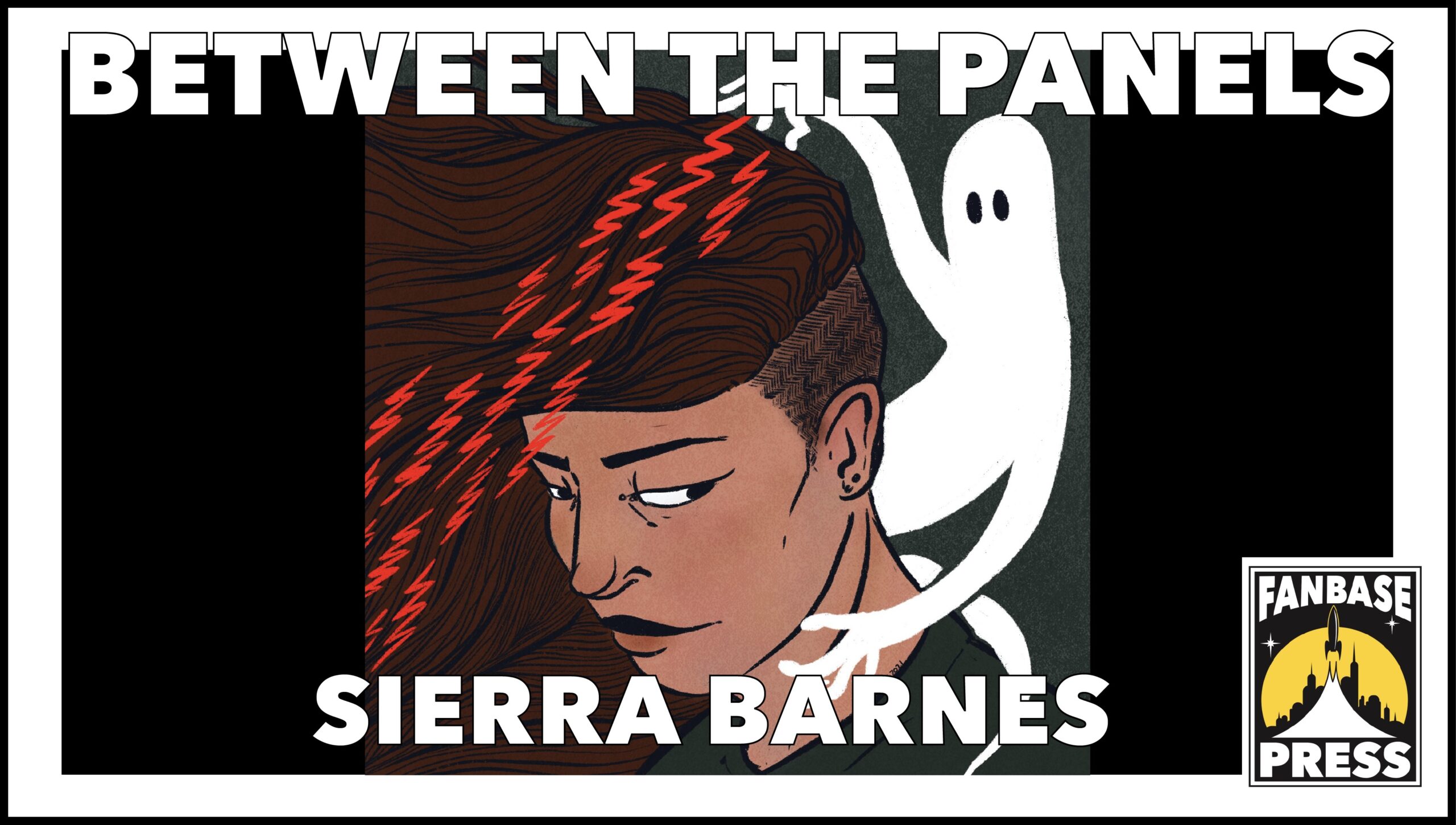“Between the Panels” is a monthly interview series focusing on comic book creators of all experience levels, seeking to examine not just what each individual creates, but how they go about creating it.
How different Sierra Barnes’ life path would have been had she stuck to her original plan of working in the history field. Instead, that love was combined with another one — art — to send this creator in an entirely new direction, one that’s led to an acclaimed webcomic and work with a growing list of comics publishers.
First off, the basics…
Your specialties (artist/writer/letterer/inker/etc.): All of it
Your home base: Washington, DC area
Website: sierrabravoart.com
Social Media
Instagram: @sierra_bravo_art
Bluesky: @sierrabravoart
Twitter: @sierrabravoart
Hans Vogel Is Dead updates Thursdays on hansvogelisdead.com
Fanbase Press Contributor Kevin Sharp: We start with the same question for all guests: Why comics? What attracts you as an artist to working in this medium specifically?
Sierra Barnes: As a kid, I was really into Tintin and Asterix and Obelix, and then in high school I discovered webcomics and was instantly hooked. While I never got into superheroes, I felt like the indie comics I read, especially ones with fantasy or historical elements, created worlds that felt more vivid and alive to me than prose alone, and as someone already interested in drawing and storytelling, I was mesmerized by how you could use the two together. I love how the juxtaposition of text and images can create meanings that are impossible with any other medium, how panels create the illusion of time, and how much you can play with visual interpretations of things like sounds and different languages and whatnot. Comics are just great!
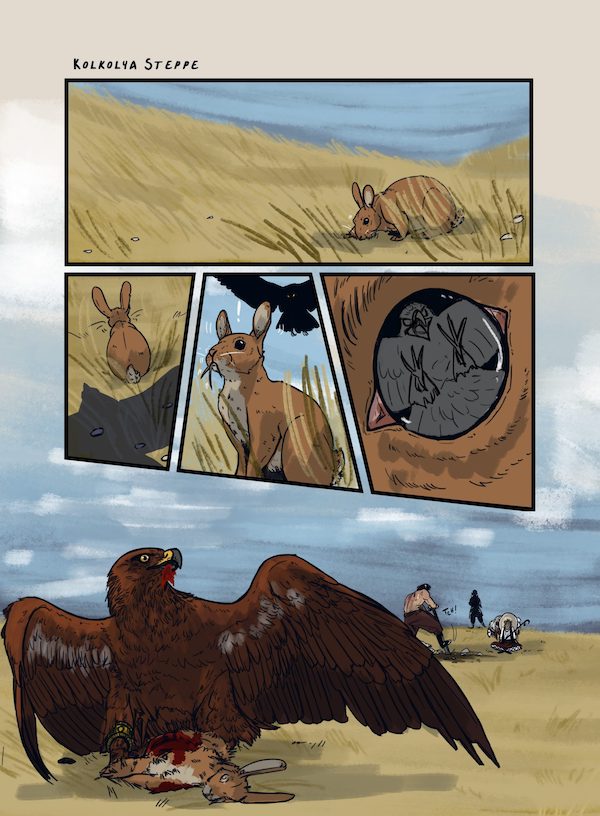
KS: Tell us a little about your artistic adventures when you were younger. What types of tools did you enjoy working with and what kinds of art did you used to make?
SB: I always loved drawing since I was a kid, although I was largely self-taught. When I was younger, I’d draw with anything you’d give me, but mostly pencils and colored pencils, since I could erase those. When I went to college, I got a bamboo tablet for Christmas and launched immediately into digital art, and that’s when I would say I started seriously thinking about drawing and working on getting better for myself. Digital remains what I feel is my strongest medium, though I also enjoy brushpen and ink and acrylic paints.
KS: Can you pinpoint roughly when the idea of an artistic career came to you? Was it an “a-ha” moment of inspiration or something that was simmering longer?
SB: An art career felt more like something I fell into than anything else. I had dreamed of making a webcomic since I was in high school, but it always felt like something that would always be out of reach or unattainable, and I figured I should probably try and get a “real job.” I wanted to be a historian, but after undergrad and living abroad for a year, I started making Hans Vogel Is Dead while looking for historian jobs and then ended up doing more and more comics and art stuff and getting more and more rejections for historian jobs and now I’m here!
KS: Which webcomics had you seen that inspired you to want to make your own? Were there particular favorites you were following or was it more the medium itself?
SB: Oh, I could spend all day recommending webcomics! I think the biggest one that I was reading in high school that I still read today is Gunnerkrigg Court by Tom Siddell. I loved both the visual art style and how he combines fantasy elements from different folklores around the world. I also love basically anything by Remeina Yee, but especially The Carpet Merchant of Konstantiyya, which again combined my loves of fantasy with my love of history in a way that continues to knock my socks off. I also read quite a bit of The Dreamer by Lora Innes during high school, and Tony Cliff’s Delilah Dirk. More recently, I’ve gotten into Bybloemen, a fantastic historical fantasy with just the most delicious linework you’ve ever seen.
KS: Your did a double major from College of William & Mary, but neither of those were art-related. Where were you in your thought process when starting school there?
SB: I love history a whole lot, and intended to be a historian after I graduated. Art never felt like a serious option for me as an occupation, it was something I did on the side. I did have a German Studies professor who encouraged me to start making comics, among other things, and I’m glad he did! While I never considered comics as a career while I was in college, the history studies I did there really did set the stage for the content of the work I make now.
KS: Next comes your MFA specifically in Comics from California College of the Arts. What did the years in between those degrees look like for you professionally?
SB: The year after I graduated undergrad, I went to Austria to teach English. I had a great time in Europe, I learned a lot, I went to a lot of museums and memorials and whatnot, but I learned that I really hated teaching so instead of going back for a second year, I went back to live with my parents. I was applying for historian positions and working a part-time job at a local historical society and was generally pretty miserable, so I started making Hans Vogel because I figured I had the time and the idea had been kicking around in my head for a while at that point. I really enjoyed making the comic, and after a few years, I thought I might as well try and take it to the next level with a Master’s program.
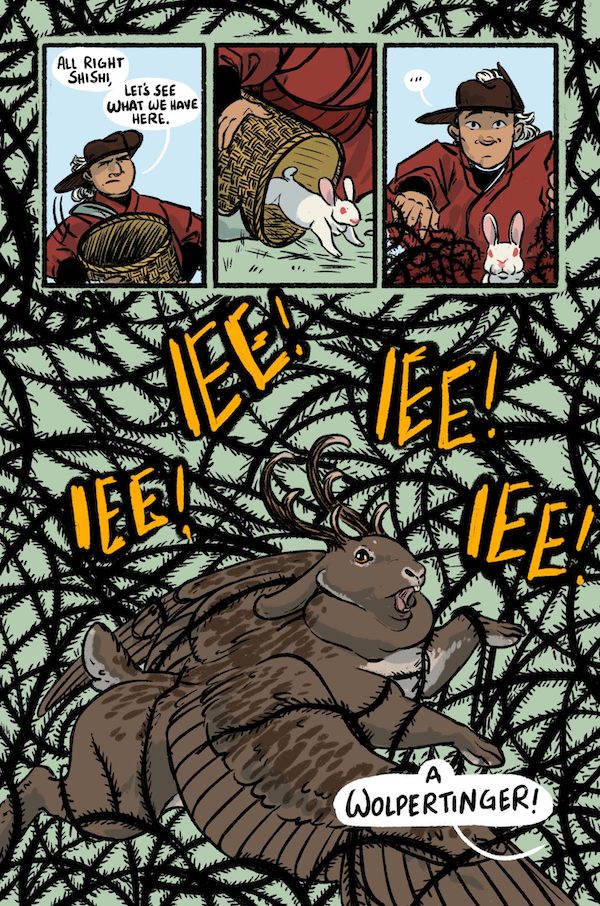
KS: How did you end up CCA?
SB: I was living in the Bay Area at the time, so the program was local, and it seemed like a good professional development type thing to do.
KS: Thinking back on your time there, if you were an art teacher today and the Sierra of that time were a student in your class, what’s a piece of advice or guidance you’d offer?
SB: I had already been doing comics for a few years by the time I was at CCA, but if I were giving advice at the start of my comics work, I would tell myself to use a standard comic book-size template for comic pages instead of just making up a size for Hans Vogel. I would have loved to go back in time to 2015 Sierra and save myself having to reformat that book three times.
KS: You mentioned you’d been wanting to make a webcomic for a while. Tell us about the origin of Hans Vogel.
SB: I had the original idea in high school as an extra credit project for my German class. The original idea was that Hans was a Hessian mercenary during the American Revolution who deserts and joins a ragtag group of Pennsylvania Dutch rebels. I ended up dropping that idea pretty fast since I realized while researching I wasn’t super interested in the time period, but I did it all in German and was pretty proud of the pages I did get out.
KS: When it came time to actually sit down and start it, how familiar with the steps of comic storytelling were you? Had you practiced it before or were you learning on the fly?
SB: I didn’t have any intention of it being anything more than a fun thing I did on the side, and I hadn’t had much comic experience before, so I was mostly making it up as I went along. You can probably tell by looking at some of the old pages!
KS: Did you have some internal measure of “success” for the comic beyond putting it out into the world?
SB: I was enjoying writing the story and making the art and just doing it felt like a win. I was pitching it around to publishers pretty early on, but I didn’t have many expectations that anyone would pick it up, so it didn’t bother me much that I didn’t hear back from anyone. Honestly, just getting it on the internet was success enough for me!
KS: How did your first official pro gig come about?
SB: I can’t remember if it was the first gig, but one of my first certainly was writing a story for the Pub Crawl anthology put out by Bad Neighbor Press. The editor of the anthology had been one of the creators in the webcomic collective where I had first launched Hans Vogel in 2015, and had reached out and asked me if I had wanted to be a part of it. I was paid in copies of the anthology. The collective had been defunct for a few years at that point, but we had stayed in loose contact, and later on down the line I worked on another anthology for them and now I’m doing pencils and inks on one of their new publisher’s first releases.
KS: Hans Vogel got collected by Dark Horse just last year. Take us through how your fun side project ultimately ended up there after you didn’t have early success pitching it.
SB: It was a journey! I had actually been scouted by Dark Horse in 2018, before I had finished Vol. 1, and we went through a six-month pitch process that was eventually rejected at the last stage. I was super bummed. I worked on it as an independent webcomic from 2015-2020, when I finished the first volume and decided to do a limited print run of 50 hardcovers for myself. I funded it out of pocket and sold all of the books within three days. Around that time, one of the publishers I had pitched to, a micropublisher based in the UK known as Cast Iron Books, sent me a note saying they were interested in picking it up. I took the sales numbers from my self-printed run and my publisher offer and found an agent who agreed to look into the contract for me. Cast Iron did a hardcover run of Hans Vogel, running a Kickstarter campaign in September 2021, and we reached our initial funding goal and then some. The book was officially released in March 2022, around which time my initial agent left the industry to become an editor, and I had to find a new one — which I fortunately did. Unfortunately, Cast Iron was not able to find distribution to the US, so they told me to find a new publisher. I still had the contact info for the DH editor who had initially scouted me for it and asked them if they were still interested in the project, this time with some nice sales data and whatnot, and fortunately for everyone they were! I got the deal for all three books in the series not long after. The final version of Hans Vogel Vol. 1 was released in October 2023.
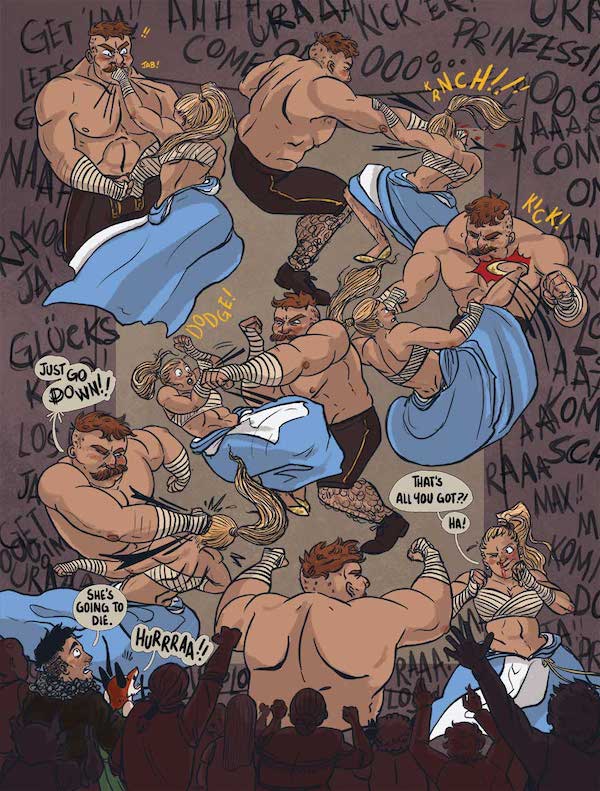
KS: At Fanbase Press, our #StoriesMatter initiative endeavors to highlight the impact that stories can have on audiences of various mediums and about the way a reader can find an important story at just the right time. What was a comic book story that had a significant impact on you when you were younger?
SB: I dropped off reading print comics for a while in high school/most of college, and then in undergrad I took a Holocaust in Lit and Film course where we read Maus. I’m sure Maus is a cliché “comic book that had an impact on you” story at this point, but it really was the book I needed to read at the time I read it. It hit me like a truck. I couldn’t stop thinking about it. Reading Maus was the moment at least some part of me, even if I didn’t really realize it fully at the time, went “yeah, I need to make comics” and set some wheels turning.
KS: And why do you think such an acknowledged classic was the right material for who you were at the time?
SB: I think there were a few factors. As I mentioned, I hadn’t read a print comic for a while at that point, and hadn’t kept up with a lot of webcomics in college, so returning to the medium with a bit of a fresh gaze helped give everything a lot more punch. I was knee-deep into my degree and was doing a lot of research on Nazi Germany and none of it was presented like Maus, so while I was working a lot with the subject, the medium of delivery stood out. It’s also a masterpiece. I think on some level Spiegelman’s relationship with his dad resonated with me in a way that I wasn’t quite ready to deal with yet and that discomfort was so powerful it made me want to try and make work like that. I don’t even know if I have a coherent explanation for why it affected me so much, it just really did.
KS: Please give a shout-out to anyone from your comics journey who was especially helpful to you. Maybe they made a key introduction, offered support when you needed it, opened an important door for you…
SB: I’d love to shout-out Professor Bruce Campbell from William & Mary, not a comics industry person but without whose slightly unhinged encouragement, I would have never even thought to do a comic in earnest and who turned me from a terrible freshman into a somewhat functioning human being. Big shout-out to Jamieson Alcorn, one of the initial Silent Chord cartoonists — the first hosting site I used for Hans Vogel! — and now fearless leader/co-founder of Very Big Comics Corp publisher, for believing in me enough to let me in on some very cool projects he had created. Melanie Gillman’s advice about your handwriting being the best match for your art has caused my wrist a lot of pain, but they are 100% correct and thanks to them I think my work has been much improved! Geri Gallas is a bit of a local comics legend here in the DMV, and she is just an absolutely lovely person, thanks to her for letting me table with her at SPX for a few years and get into the DMV comics scene. Also check out her work, it’s fantastic. Huge shout-out to the entire Comicazi comic book store team, especially the Ladies of Comicazi, one of the greatest comic book stores around and certainly the best in Boston and hosts of my favorite convention ever LadiesCon for being just absolutely lovely, supportive people and for doing incredible work supporting new and established comic creators both. Final shout-out has got to be my other beloved comic book store, our local Fantom and their team–thanks for letting me stomp around and give some workshops and book launch events. Y’all are just fantastic and if you’re ever in DC, I can’t recommend them highly enough!
KS: Imagine a Comic Book Hall of Fame and you get to induct one title that you think represents this medium at its finest. What gets your plaque & why?
SB: I feel like I gotta say Maus, but also I’d like to put out Tom Siddell’s Gunnerkrigg Court. Any comic that has been faithfully updating M/W/F for 12+ years has earned my undying respect, but I love that you can see the evolution of the art style over time and how well the story grows organically from elements that take literal months or even years to pay off. It’s hands down one of the best webcomics out there, and I’d love to see it receive some more recognition.
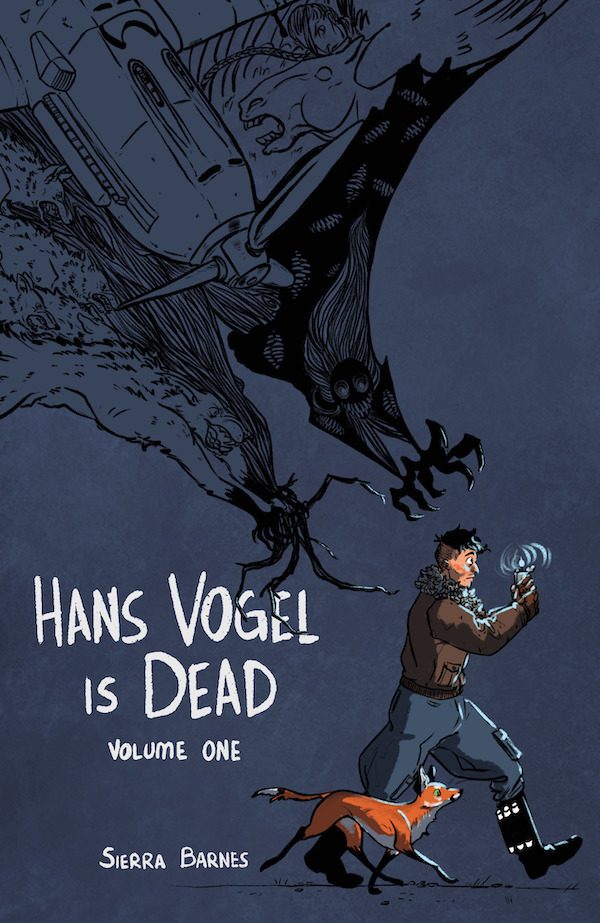
KS: Finally, please let readers know what you have out now, what you have coming out, and anything else you’d like to spotlight.
SB: Right now I’m working on Hans Vogel Is Dead Vol. 2, which will be out in October 2025! Vol. 1 is out in stores now, and while I’m working on some other projects, none of them will be ready to go for a while, so stay tuned!

